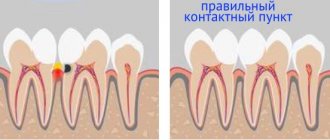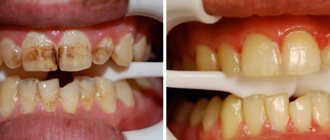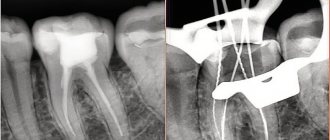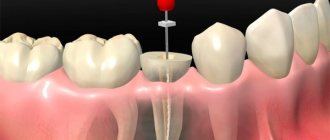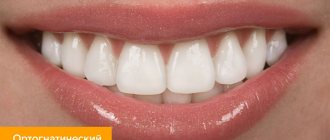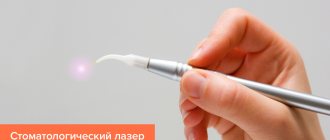Light composites, which are one of the most popular caries treatment technologies today, with all their positive qualities, have 3 serious drawbacks: shrinkage during polymerization (or light curing); the appearance of internal deformations, as a result of which the thin walls of the filling break off; insufficient polymerization (or hardening) of the filling. That is why they cannot be used for large dental defects. In such a situation, the best option is to use tabs.
The first inlays were made at the beginning of the 20th century. Moreover, this type of replacement of dental defects has been actively used in the West all these years, although inlays were made mainly from precious metals. Today, inlays made of porcelain (more precisely, ceramics) are gaining the greatest popularity all over the world. Now the victorious march of ceramic inlays has reached us.
An inlay is, surprisingly, also a filling, only made not in the patient’s mouth, but in a laboratory. Even a composite inlay made from conventional filling material is free from the disadvantages described above that are inherent in a filling made in the mouth. If we talk about a ceramic inlay, it generally significantly surpasses any other in its properties.
The fact is that of all the materials used in dentistry, ceramics are closest in their properties (strength, color, light reflection, etc.) to tooth enamel. A porcelain inlay glued to the tooth almost completely restores its strength. Therefore, where there is extensive tooth decay, it is preferable to place an inlay rather than a filling. In many cases, when the destruction of the coronal part of the tooth is great, and the tooth is still alive, the only thing that allows you to avoid depulping and covering the tooth with a crown is an inlay.
The impetus for the development of this technology was the improvement of the mechanism for gluing (or adhesion) of fillings to the tooth. If previously fillings were held in the cavity due to their geometry, now doctors have begun to create microscopic irregularities in the enamel, into which the glue that connects the filling to the tooth flows.
Today, dental adhesives (they are called adhesive systems) of the fourth and fifth generations penetrate micropores in all layers of the tooth, both enamel and dentin. Penetrating into all the microscopic irregularities, of which there are a huge number, the glue (adhesive) creates such a connection between the filling and the tooth that in an experiment, when trying to tear off the filling, it comes off along with part of the tooth. Thanks to the creation of dental miracle glues (adhesives), it became possible to glue not only composite fillings to teeth, but also porcelain, metal, and many other materials.
Types of products
Experts distinguish between two main types of orthopedic structures: stump and restorative. A ceramic core inlay is required to restore the tooth core for subsequent fixation of the crown. Most often it is used for prosthetics of incisors. Restorative structures are used for chewing teeth when one or two surfaces are damaged. In addition to high aesthetics, they are characterized by reliability and durability. Also, the tabs are distinguished by the material used. Below are the most common materials from which products are made.
- pressed ceramics. Products are produced using porcelain injection molding. The procedure is carried out under conditions of high temperature and pressure. Compared to orthopedic structures made of metal or zirconium dioxide, they are not as durable, but are ideal from an aesthetic point of view;
- zirconium dioxide. They are made by grinding finished metal oxide blanks. Grinding is carried out automatically using a ready-made impression (plaster model) of a damaged molar or premolar. Thanks to computer control, finished structures are characterized by high quality. Upon completion, the workpiece is fired, fusing the porcelain mass. Zirconium dioxide is a high-tech material for orthopedic structures, and therefore is in special demand. From an aesthetic point of view, such inlays are in no way inferior to porcelain products, and in terms of strength they are not inferior to metal products;
- metal. The metal most often used is gold or a silver-palladium alloy. Such designs are reliable, but do not have high aesthetics;
- metal ceramics. This is the latest orthopedic design, which is distinguished by high aesthetics, but at the same time cannot boast of proper quality. Due to thermal exposure, such products often fall out of the mouth. Most experts advise installing a structure made of zirconium dioxide or pressed ceramics rather than metal ceramics.
Pin
This is a rod installed in the root of the tooth to strengthen it and ensure subsequent treatment. It is installed when there is severe destruction, when no more than half of the root remains. The materials used for manufacturing are polymers or metals. A serious disadvantage of metal pins is the need to greatly expand the root canal, as a result of which its strength decreases. Fiberglass pins do not have this drawback and are similar in characteristics to natural dentin.
When choosing a manufacturing material, we proceed from specific requirements:
- For prosthetics of the front teeth, fiberglass is used;
- Metal products are intended for chewing units with severe destruction;
- Carbon fiber is a universal option, suitable for any teeth.
There are two types of fastening:
- Passive – on dental cement, without load on the root;
- Active - the pin is screwed into the root using a thread.
Ceramic inlay e max: main indications
Many people mistakenly believe that ceramic inlays are a type of regular filling. In fact, they belong to the category of high-tech microprostheses. Its parameters and characteristics significantly exceed any, even the most modern and high-quality filling material. Among the main indications for installing ceramic inlays are:
- destruction of the coronal part by 30% or more;
- preparing a molar or premolar for the installation of permanent orthopedic structures, for example, bridges;
- increased abrasion of enamel;
- the presence of a large cavity that was formed as a result of an advanced carious process;
- increased sensitivity of molars or premolars to external factors;
- mechanical damage.
If, after fixing the orthopedic structure, pronounced painful sensations occur, you should not delay your visit to the dentist. Most often, pain and discomfort are a sign that the product was installed incorrectly. To avoid such situations, treatment should be carried out only in trusted dental clinics.
Differences
- The pin puts pressure on the root of the tooth, which can cause it to become loose; there is pressure on adjacent teeth, and the inlay eliminates this load.
- Time of use - the pin can be used for up to 3 years, the inlay - much longer, almost 10 years.
- The pin is a single design, but the tab can separate.
- It is not difficult to make a pin, but to make an inlay, laboratory specialists are involved and special studies are carried out.
- The installation of the pin is carried out in one visit to the dentist; to install the inlay, you will have to visit the doctor at least twice.
- If the tooth has a crooked root, you can only use an inlay.
- The cost of an inlay is significantly higher than a pin.
- Preparing the tooth for the installation of a pin is relatively gentle; in order to install the inlay, a large amount of tissue is removed.
Contraindications for installing ceramic inlays
The emax tab also has some contraindications for installation. There are no absolute contraindications, but there are relative and temporary ones, which are recommended to be eliminated before installing a ceramic onlay. Among them, insufficient oral hygiene is the most common contraindication. In this case, a specialist performs professional cleaning and prescribes additional oral care methods that can be done at home.
In case of carious lesions of the teeth, the dentist carries out treatment, and after it proceeds to install the structure. Experts do not recommend installing onlays on the last molars (“eights”). They do not perform a chewing function, so in case of severe destruction, the easiest way is to completely get rid of them without spending time on restoration.
It will not be possible to carry out the installation if only one wall of the tooth remains (at least two remaining walls are required). Problems can arise when the cavity depth is insignificant (less than 2 mm) or the presence of pathological cavities that go deep into the dentin. For bruxism (teeth grinding), the installation of pads is not recommended, since they will quickly wear out, which will significantly reduce the service life. However, you can use a special device (night guard) that will prevent the teeth of the lower jaw from rubbing against the teeth of the upper jaw.
What is a filling?
A filling is the restoration of a tooth defect formed after treatment of caries or other tooth damage using filling materials.
In dentistry, there are many filling materials that can replace such defects. Today, the most practical to use are photocomposites (light-curing filling materials). Despite their advantages, fillings also have disadvantages that significantly reduce the lifespan of a tooth:
- shrinkage during light curing,
- chipping of the thin walls of the filling,
- instability to external influences - darken over time, color changes due to exposure to tobacco, coffee and other dyes.
Guided by these shortcomings, the use of fillings in case of large damage is inappropriate. In such situations, the most optimal solution would be to use tabs.
Ceramic tooth inlay: advantages and disadvantages of products
Currently, ceramic onlays are the most common method of restoring incisors, molars or premolars; they are recognized as reliable and durable. Unlike composite fillings, they are not made in the patient’s mouth, but in isolation, in a dental laboratory (using impressions). This allows you to create an anatomically correct tooth shape with increased accuracy. This factor is very important for the area of contact with the adjacent incisor, molar or premolar. The use of ceramic inlays makes it possible not to resort to crowns if the root bases of the teeth are intact. The main advantages of the products include:
- high aesthetic qualities. Ceramic onlays are no different from natural molars or premolars. The material fully matches their visual characteristics. Only a specialist can notice the difference upon careful close examination;
- durability (compared to a conventional filling). If you follow all the recommendations prescribed by your doctor, the orthopedic design can last more than 10 years. For comparison, a regular filling lasts about 3-4 years;
- no changes in appearance. Ceramics do not darken over the course of a year, so the original color remains intact for the entire duration of wear. It is completely resistant to dyes and other external factors;
- no shrinkage and polymerization after fastening. The main factor influencing the development of secondary carious lesions is pathogenic microorganisms that enter the gap between dentin and filling material. It occurs as a result of shrinkage of the filling. Under the influence of ultraviolet radiation, the filling significantly decreases in volume and sags. e max structures retain their dimensions and do not change during the manufacturing and installation process. Their grinding occurs at the same time as the tooth tissues;
- complete safety. The material does not have a negative effect on the human body and does not provoke the development of allergic reactions;
- high strength. Unlike conventional fillings (light, chemical), the inlay is more securely fixed and is characterized by increased resistance to mechanical and thermal stress.
The emax ceramic inlay has no significant disadvantages. Some are confused by the time spent on manufacturing and installing orthopedic structures, which, unlike conventional fillings, require several visits to the dentist's office. Relative disadvantages include the high price (compared to inlays made of other metals). It is worth noting that their quality, aesthetics and long service life justify their relatively high cost.
Stump tab
Stump tab
is a microprosthesis that restores the tooth stump and is fixed in the root canal. The product is also called a root tab or crown tab. It is a cast or collapsible pin structure. The microprosthesis consists of two parts: the lower one follows the shape of the canal and is fixed in it, and the upper one is a support for the artificial crown and has the appearance of a stump (ground to fit the crown of the tooth). The lower part may have one pin (during the restoration of single-rooted teeth) or 2-3 (in multi-rooted teeth). A stump inlay is used when the tooth is severely damaged or only the root is present. The product allows you to fully restore a damaged tooth and extend its service life.
Indications and contraindications
Indications for the manufacture of a pin insert are the following cases:
- The index of destruction of the occlusal surface of the tooth (IROPD) is more than 50-60-100%;
- The presence of only the root;
- Fracture of the crown at the level of the neck of the tooth;
- Significant crown defects;
- In order to strengthen the root;
- Inability to apply fillings or install a crown.
A contraindication to installing a root inlay is the presence of periodontal tissue disease, periodontal inflammation, perihilar cysts and granulomas, and root cracks. And also a root canal that is too short, narrow, curved, and poorly filled. An inlay is not installed if the crown of the tooth was lost several years ago and root treatment was not carried out.
Types of stump inlays
According to its design, the tab can be solid or collapsible. Solid cast is a monolithic structure that is durable and reliable. A collapsible design consists of a stump and a pin (from 1 to 2-3), it is made in multi-rooted teeth, when it is impossible to make a solid one. There are also single-root, double-root and triple-root tabs based on the number of channels, respectively.
Depending on the material used, the products are made of metal, ceramic and zirconium dioxide. Metal products are made from alloys of various metals: chromium-nickel, chromium-cobalt, silver-palladium, steel, titanium, gold. Unlike other designs for prosthetics, the use of metal is relevant and effective. The product is located in the middle of the tooth, covered with any crown, so the insufficient aesthetics of the metal is hidden. Metal inlays are used mainly in the area of the lateral teeth, where there is a lot of chewing pressure.
Ceramic and zirconium dioxide inlays are indicated for the restoration of the anterior group of teeth. They are aesthetic and, unlike metal, will not show through or disrupt the aesthetics in any way. Such products are high quality, strong and durable. Zirconium dioxide has a higher cost, since the material is ultra-strong, bioinert, hypoallergenic and is as close as possible to the natural tissues of the tooth.
Advantages of stump inlays
The advantages of stump inlays include:
- The ability to save a tooth even in the most difficult clinical situations;
- Longer lifespan of natural teeth;
- Reliable support for any artificial crown or prosthesis;
- High mechanical strength;
- Individual manufacturing guarantees a tight fit and excellent functioning of the product;
- Uniform distribution of chewing load;
- Possibility to replace the crown without removing the inlay from the root canal;
- Can be used to restore anterior and lateral teeth;
- Wide selection of materials for the tab;
- Reliable fixation reduces the risk of infection in the canal and periodontal tissue to a minimum;
- Long service life;
- If necessary, the structure can be removed without harm to the tooth;
- Low cost.
The disadvantages of the product include the need to visit a specialist several times, since a complete restoration of a tooth with a crown will take 3-4 visits. As well as high requirements for the root and the impossibility of using it in all clinical cases.
Treatment process
Treatment with a crown tab is carried out only after examining the root, which must meet all requirements and not have inflammatory processes. The first stage of therapy is mechanical, medicinal treatment of the canal and its filling. At the second stage, the root is unsealed by 2/3 and the area for the product is prepared. After this, the dentist takes an impression from the inside of the canal; for this, impression material is introduced into the root, which, after hardening, is removed and transferred to the dental technician. A custom inlay is made in a dental laboratory. At the next visit, fitting and fixation of the finished product is carried out. Next, an impression is again taken from the inlay and tooth to make a crown or prosthesis.
Manufacturing and installation stages
Manufacturing and installation of an orthopedic structure is not difficult and does not take much time. At the initial appointment, the dentist examines the oral cavity to determine indications and contraindications for the procedure. If contraindications are identified, they are eliminated, after which they proceed to therapy. If necessary, endodontic treatment and hygienic treatment of the diseased tooth are carried out. By analogy with standard filling, the specialist removes all destroyed tissue from the tooth, forming an area for a microprosthesis. After this, a cast is made that exactly repeats its shape.
The production time for an emax ceramic inlay based on the impression obtained (3D modeling results) is about 5-10 days. At this time, a temporary filling material is placed in the patient's cavity. The onlay is made in laboratory conditions, taking into account the individual characteristics of the patient’s dental system. The orthopedic structure is fired and covered with layers of ceramics. At the secondary appointment, the patient’s temporary filling is removed and a finished microprosthesis is installed. It is attached using special cement, which firmly adheres to the ceramics and enamel of the tooth. This guarantees a secure fit. At the end of the process, the surface is polished. The whole procedure takes no more than 120-150 minutes.
How to care
During the manufacture of the product, the patient walks with a temporary filling, so during this period great care should be taken to reduce the risk of its falling out. Immediately after installation, the dentist will recommend that the patient refrain from eating solid foods so as not to put too much strain on it. The specialist will also talk about quality oral hygiene. Patients often wonder what complications are possible. If the procedure was performed by a competent dentist, then no complications will arise. If ceramic onlays on a tooth have become cemented for one reason or another, you need to see a doctor as soon as possible. According to reviews, ceramic tooth onlays are an excellent way to restore the functionality of teeth. Before installation, you will need to cure caries and other dental diseases. What is better to place, a ceramic onlay on a tooth or a filling, will be advised by a competent dentist after a detailed examination of the oral cavity and diagnostic procedures.
Ceramic dental inlay: care features
The ceramic inlay and onlay do not require complex care. You need to care for your teeth like you would for regular teeth - brush twice a day, use floss and mouth rinses after each meal. It is worth noting that ceramic inlays, due to their physical properties, do not require additional care (unlike light fillings) - professional cleaning.
In order to promptly detect leaks in the Emax tab, you need to regularly visit the dentist’s office (once every six months). When a dark stripe appears, there is a high probability that pathogenic microorganisms have begun to penetrate under the ceramic inlay, which provoke the development of a carious process. On average, the service life of ceramic structures is about 7-8 years. Subject to all rules and hygiene standards, as well as the absence of increased stress, they can last several years longer.
You can install a ceramic inlay in Moscow at the reliable A-Medic clinic. Qualified specialists with extensive experience work here, which guarantees a positive result. The orthopedic design is no different from natural teeth and can last for many years. In the event that there are contraindications to the installation of this product, A-Medic dentists will be able to select another method of tooth restoration.
